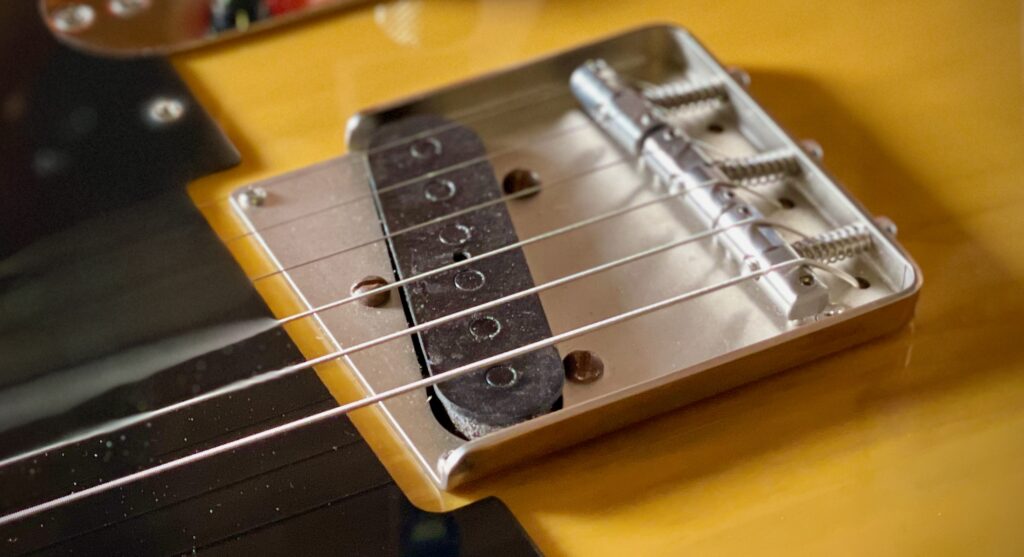
I recently bought a new bridge pickup for one of my cheap-and-cheerful Esquire guitars.
How did I get on with it? Read on for my First Impressions.
What Did You Buy?
I bought a Seymour Duncan Antiquity Tele bridge pickup. This is their pickup aimed at recreating the sound of original early 50s Fender Telecasters.
Why Did You Buy It?
I’ve had The Squirrel – my Squire FSR 50s Esquire – for about 12 months now. Forget the name on the headstock. This guitar isn’t just a fun little go-kart, it’s good enough to upgrade to get the very best out of it.
And the nice thing about these mod-platform guitars is that you can do them in stages to spread out the cost.
I’ve already upgraded the bridge and (by accident! a story for another day) the tuning machines. All that’s left to upgrade are the pickup and the pots. And, as far as I’m aware, there’s nothing much wrong with the pots.
There’s nothing really wrong with the stock bridge pickup either, to be honest. It’s a perfectly capable pickup. I just wanted to try and get the very best out of this guitar, and the Antiquity seemed like the right way to do that.
My only prior experience with Antiquities has been the Eastman SB-59v guitars. I’ve played one fitted with Antiquities, and I absolutely loved how they sounded and how they felt to play. Since then, I’ve been looking for an opportunity to drop an Antiquity into one of my guitars.
What Other Pickups Did You Consider?
I didn’t really look at anything else. The Antiquity was my first choice, and none of the research I did convinced me to change my mind on that.
That was a good thing, because right now, most aftermarket pickups are “out of stock” here in the UK …
Any Problems Fitting It To The Squier?
As I understand it, you’ve got to be careful when buying aftermarket parts for Squier guitars. American-made Fenders guitars use the imperial system for measurements; so do Mexican-made Fenders. Far-east factories normally use the metric system instead.
Fortunately, pickups tend to be
How Has It Transformed The Guitar?
When I went to pick it up from the shop, Kris told me, “it’s completely different from what was in there before,” and he’s not wrong!
Best way I can describe it is that the Esquire’s sound now matches its looks. I’ve never played a 50s blackguard Tele myself, but I’d expect it to sound something like how The Squirrel now sounds.
It’s bright and harsh in a good way. All the energy is in the upper-mids and treble, giving it this really intriguing vintage character. So far, I’m not finding it ice-picky or fatiguing either. There’s hardly any bass in the signal – which is a big change from the stock pickup. I feel that this is more in keeping with the spirit of what I imagine the 50s sound to be.
This pickup drives my signal chain less than I expected. It’s a much lower output pickup than the pickup in my other Squier Esquire, or the Twisted Tele in my American Deluxe. That allows me to get a really nice twangy clean picked tone just by rolling the volume down a little.
I’m still dialling in the pickup height, so things may change a little there over the coming weeks.
The other thing that stands out is that – for lack of a better description – there’s more complexity to the tone now.
Final Thoughts
I always liked The Squirrel, and now this guitar has its own voice. It doesn’t sound like any of the other Telecasters or Esquires that I’ve got access to.
This is a good thing.
Does it deliver that 50s sound? I’ve nothing to compare it against, so I’m the wrong person to ask, sorry. All I can say is that I’m very happy with it, and I feel that I made the right choice by choosing an Antiquity Tele pickup.
In fact, I’m now wondering if Hedgehog (my Squier 60s Esquire) would benefit from an Antiquity II Tele pickup too … 🤔

2 Replies to “First Impressions: Seymour Duncan Antiquity Tele Bridge Pickup”